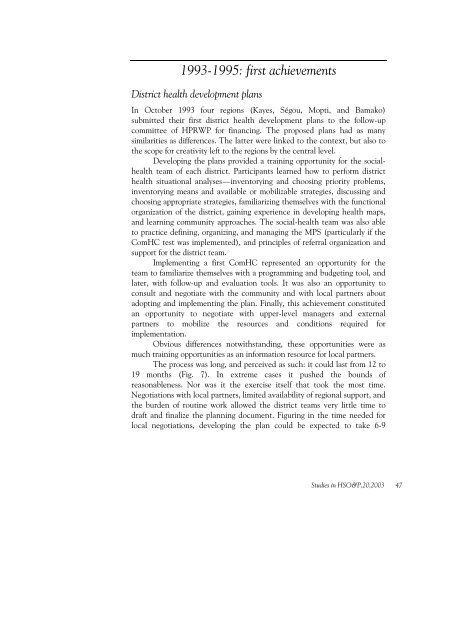Health sector reform in Mali, 1989-1996 - TropMed Central Antwerp ...
Health sector reform in Mali, 1989-1996 - TropMed Central Antwerp ...
Health sector reform in Mali, 1989-1996 - TropMed Central Antwerp ...
Create successful ePaper yourself
Turn your PDF publications into a flip-book with our unique Google optimized e-Paper software.
1993-1995: first achievements<br />
District health development plans<br />
In October 1993 four regions (Kayes, Ségou, Mopti, and Bamako)<br />
submitted their first district health development plans to the follow-up<br />
committee of HPRWP for f<strong>in</strong>anc<strong>in</strong>g. The proposed plans had as many<br />
similarities as differences. The latter were l<strong>in</strong>ked to the context, but also to<br />
the scope for creativity left to the regions by the central level.<br />
Develop<strong>in</strong>g the plans provided a tra<strong>in</strong><strong>in</strong>g opportunity for the socialhealth<br />
team of each district. Participants learned how to perform district<br />
health situational analyses—<strong>in</strong>ventory<strong>in</strong>g and choos<strong>in</strong>g priority problems,<br />
<strong>in</strong>ventory<strong>in</strong>g means and available or mobilizable strategies, discuss<strong>in</strong>g and<br />
choos<strong>in</strong>g appropriate strategies, familiariz<strong>in</strong>g themselves with the functional<br />
organization of the district, ga<strong>in</strong><strong>in</strong>g experience <strong>in</strong> develop<strong>in</strong>g health maps,<br />
and learn<strong>in</strong>g community approaches. The social-health team was also able<br />
to practice def<strong>in</strong><strong>in</strong>g, organiz<strong>in</strong>g, and manag<strong>in</strong>g the MPS (particularly if the<br />
ComHC test was implemented), and pr<strong>in</strong>ciples of referral organization and<br />
support for the district team.<br />
Implement<strong>in</strong>g a first ComHC represented an opportunity for the<br />
team to familiarize themselves with a programm<strong>in</strong>g and budget<strong>in</strong>g tool, and<br />
later, with follow-up and evaluation tools. It was also an opportunity to<br />
consult and negotiate with the community and with local partners about<br />
adopt<strong>in</strong>g and implement<strong>in</strong>g the plan. F<strong>in</strong>ally, this achievement constituted<br />
an opportunity to negotiate with upper-level managers and external<br />
partners to mobilize the resources and conditions required for<br />
implementation.<br />
Obvious differences notwithstand<strong>in</strong>g, these opportunities were as<br />
much tra<strong>in</strong><strong>in</strong>g opportunities as an <strong>in</strong>formation resource for local partners.<br />
The process was long, and perceived as such: it could last from 12 to<br />
19 months (Fig. 7). In extreme cases it pushed the bounds of<br />
reasonableness. Nor was it the exercise itself that took the most time.<br />
Negotiations with local partners, limited availability of regional support, and<br />
the burden of rout<strong>in</strong>e work allowed the district teams very little time to<br />
draft and f<strong>in</strong>alize the plann<strong>in</strong>g document. Figur<strong>in</strong>g <strong>in</strong> the time needed for<br />
local negotiations, develop<strong>in</strong>g the plan could be expected to take 6-9<br />
Studies <strong>in</strong> HSO&P,20,2003 47











